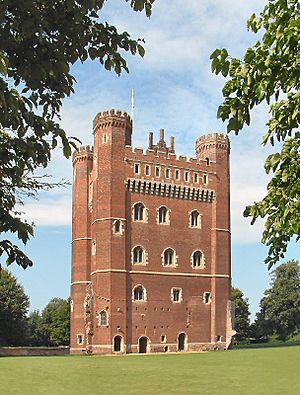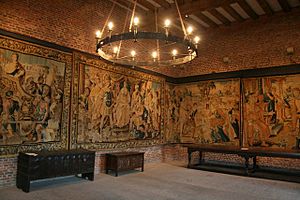Tattershall Castle, Lincolnshire facts for kids
Tattershall Castle is an amazing old building located in Tattershall, a town in Lincolnshire, England. It's a famous castle that has been looked after by the National Trust since 1925. This means it's protected so everyone can enjoy its history and beauty.
Contents
Discovering Tattershall Castle's Past
Tattershall Castle started out as a stone castle or a strong, fortified house built by Robert de Tattershall way back in 1231. But the castle you see today was mostly rebuilt and made much bigger by a powerful man named Ralph Cromwell, 3rd Baron Cromwell. He was the Lord High Treasurer of England in the 1400s, which meant he was in charge of the country's money!
Why Bricks? A Fashionable Choice
Lord Cromwell chose to build his castle using bricks, which was quite unusual for England at the time. Most castles were made of stone or wood. Using bricks was a new fashion, brought over by weavers from a place called Flanders. Even though there was plenty of stone nearby, Cromwell wanted his castle to look modern and stylish. About 700,000 bricks were used to build it! People have even called it "the finest piece of medieval brick-work in England." Scientists used a method called tree ring dating to figure out that the building work happened between 1406 and 1431.
From Grand Home to Neglect
Of Lord Cromwell's amazing castle, the 130-foot-high Great Tower and its surrounding moat are still standing. It's thought that the castle's main rooms were once incredibly fancy, with huge Gothic fireplaces and beautiful tapestries on the walls. Some say it was like a grand country house pretending to be a fortress!
Lord Cromwell passed away in 1456. The castle was then owned by his niece, Joan Bouchier. But after her husband died, the king took the castle. It stayed in royal hands from King Edward IV to King Henry VIII. Later, in 1560, Sir Henry Sidney got the castle back and sold it to Lord Clinton, who later became the Earl of Lincoln. The Earls of Lincoln owned it until 1693. After that, it was passed to another family, the Fortesques, but sadly, it started to fall apart.
Saving the Castle's Treasures
By 1910, Tattershall Castle was put up for sale. Its most valuable parts were the huge medieval fireplaces, which were still in place. An American buyer purchased them, and they were actually ripped out and packed up to be shipped away!
But then, Lord Curzon of Kedleston stepped in just in time. He bought the castle and was determined to get the fireplaces back. After a big search across the country, they were found in London and brought back to their rightful home. Lord Curzon worked hard to restore the castle between 1911 and 1914. When he died in 1925, he gave the castle to the National Trust. Today, it's one of the most important brick castles from the 1400s still standing in the United Kingdom.
Lord Curzon's experience with Tattershall Castle made him realize how important it was to protect old buildings in Britain. This led to a law being passed in 1913 called the Ancient Monuments Consolidation and Amendment Act 1913, which helps protect historical sites.
How Tattershall Castle Was Designed
The castle is shaped like a rectangle. It has an inner moat (a ditch filled with water) and an outer moat around that. The inner area, called the Inner Ward, was where the first castle from the 1200s stood. The original entrance was on the north side.
The Outer Ward, between the two moats, was where the stables for horses were kept. The Middle Ward, which you reached by a bridge from the Outer Ward, had a gatehouse and a guardhouse. Today, you enter the castle through this Middle Ward. The Inner Moat surrounds the Inner Ward, where the Great Tower and the kitchens (which are no longer there) were located.
Exploring the Great Tower
The Great Tower is about 66 feet (20 meters) wide. It has separate entrances for the basement, the ground floor (called the Parlour), and the spiral staircase that leads to the upper floors. This suggests that the basement and ground floor were for everyone to use, while the three big rooms upstairs were private suites, like a special apartment for the Lord. The tower's design was simple, with four floors that got a little bigger on each level because the walls became thinner.
The huge fireplaces show that each floor was meant to be one large room, not divided into smaller ones. One of the four corner towers holds the staircase, but the other three had extra rooms on each floor.
What Each Floor Was Used For
- The basement was used to store spices and other kitchen supplies. During the English Civil War, it's believed it was used as a prison.
- The ground floor was the Parlour. This is where local people would come to pay their rent to the Lord.
- The first floor of the private suite was the Hall. This was used to entertain guests and have big dinners.
- The second floor was the Audience Chamber. Only the most important guests would have been allowed here. A brick hallway led to a small waiting room before the grand Audience Chamber. Today, this room has beautiful Flemish tapestries that Lord Curzon bought.
- The third floor would have been the Private Chamber, where the Lord would go to sleep at night.
Above these floors are the roof gallery and battlements. From here, you can see amazing views across the Lincolnshire countryside, all the way to Boston in the south and Lincoln in the north. You can't go into the small corner towers today.
The brick foundations sticking out into the moat, south of the Great Tower, show where the 15th-century kitchens used to be.
Today, the old guardhouse (about 328 feet or 100 meters northeast of the tower) is the gift shop. The castle grounds are also home to several beautiful peacocks.
Visiting Tattershall Castle Today
Tattershall Castle is open to the public every day from 10:30 AM, with the last entry at 3:30 PM. The Parlour room on the ground floor is even licensed for civil wedding ceremonies, so people can get married there with up to 80 guests!



